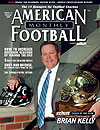Article CategoriesAFM Magazine
|
5 Things Every Youth Coach Must Do Today to Win in the Fall - .COMby: David MarcoAFM Youth Coaching Expert © More from this issue Welcome to my first article in American Football Monthly’s Youth Coaching Expert column. I have been fortunate enough to have had a success at the youth coaching ranks and it will be my goal to impart some of the lessons that I have learned, both good and bad, over the years. I will not be writing these columns for the coaches that get the super fast kids where you can just pitch them the ball and they go and make magic happen. You guys probably don’t need my help! Instead, I am going to write for the other 95% of youth coaches that have average to poor talent. Hopefully I can show you how to get the most out of your players including the out-of-shape, slow ones. This month I would like to talk to you about what a coach needs to do to improve himself in the off-season. While all of us learn lessons during ....The full article can only be seen by subscribers.
|
|
|||||||
| HOME |
MAGAZINE |
SUBSCRIBE | ONLINE COLUMNISTS | COACHING VIDEOS |
Copyright 2025, AmericanFootballMonthly.com
All Rights Reserved





